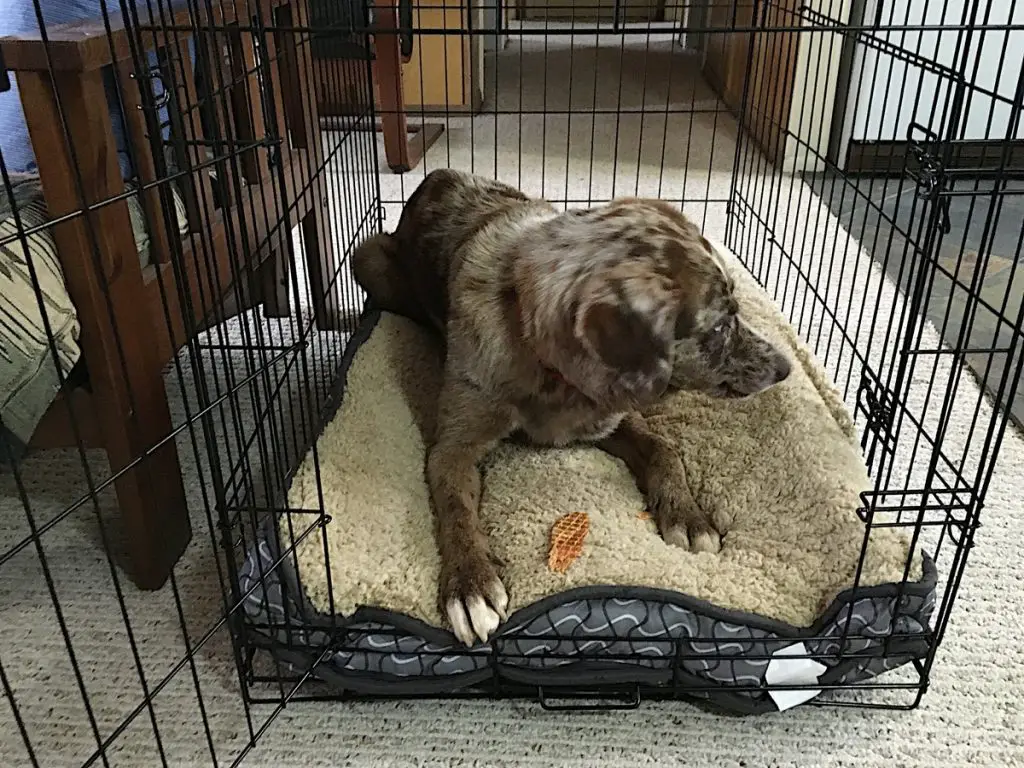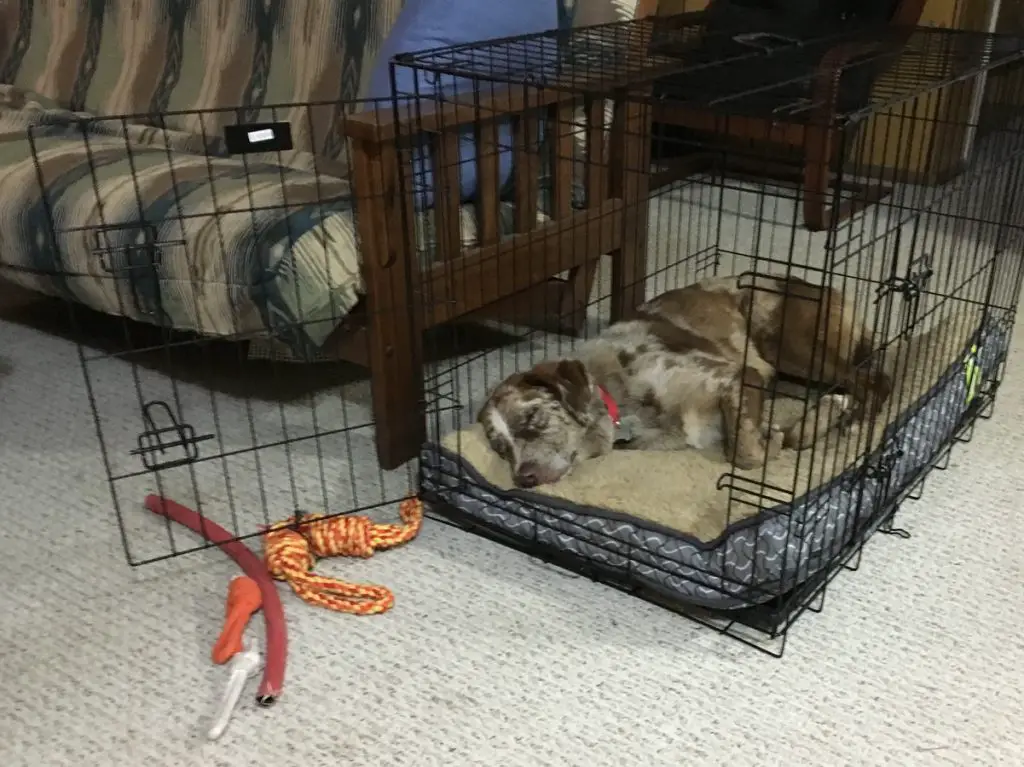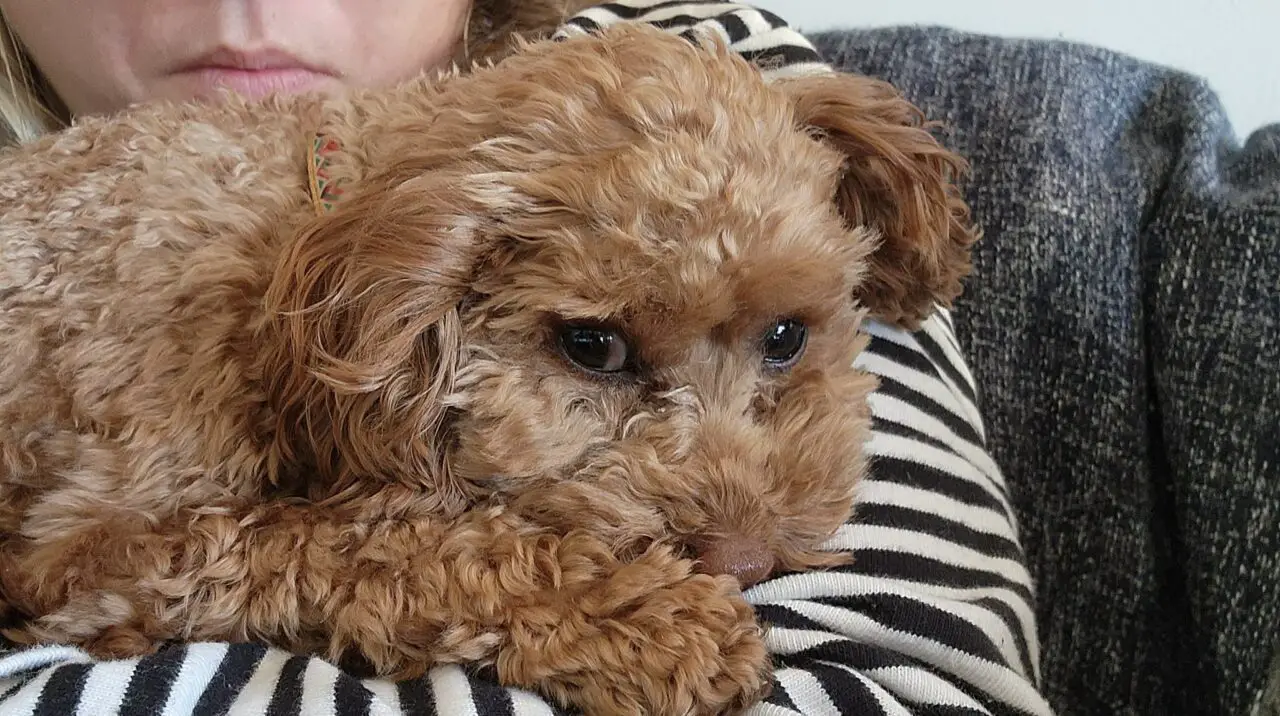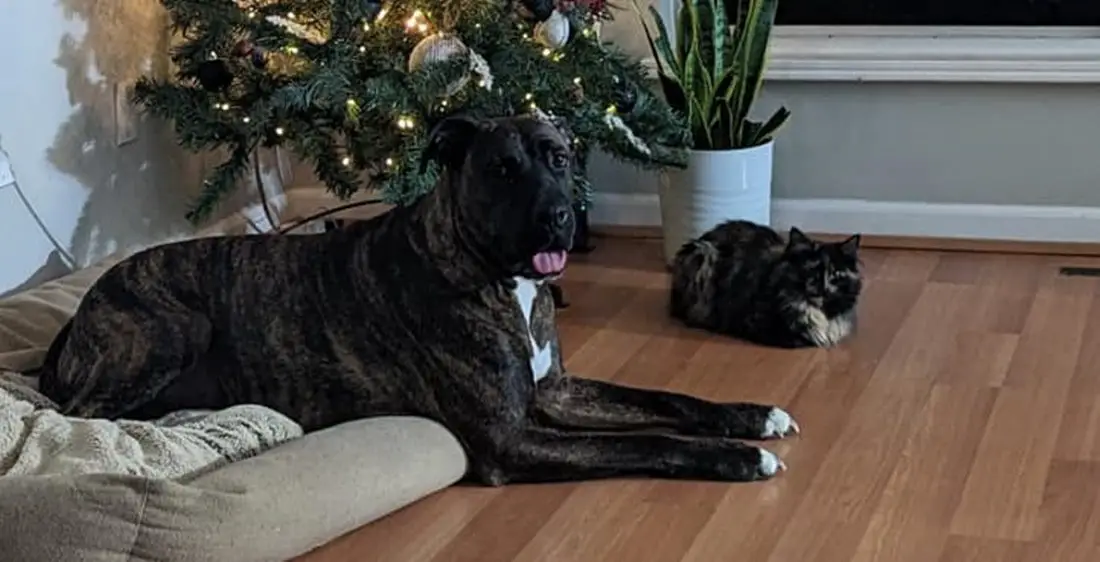Are you concerned that your Australian Shepherd will despise its crate? This is a common reaction among pet owners when they first begin the process.
The good news is that many dogs grow to appreciate having their own space in your home where they can relax.
It does take patience, and you should proceed slowly through these steps to ensure that your puppy or older dog has a positive training experience.
- Key Takeaway
- How To Crate Train an Australian Shepherd
- How Long Should You Leave a Dog Crying In a Crate?
- How Can I Stop My Dog From Crying In Their Crate?
- FAQs
- Q: What is crate training?
- Q: Why should I crate train my Australian Shepherd?
- Q: How do I choose the right crate for my Australian Shepherd?
- Q: How do I introduce my Australian Shepherd to the crate?
- Q: How long should I leave my Australian Shepherd in the crate?
- Q: How do I make the crate a comfortable space for my Australian Shepherd?
- Q: Can I use the crate as a form of punishment?
- Q: How can I prevent my Australian Shepherd from becoming anxious or stressed in the crate?
- Q: What do I do if my Australian Shepherd whines or barks when in the crate?
- Q: Can I use the crate to housetrain my Australian Shepherd?
- In Conclusion
Key Takeaway
- Crate training an Australian Shepherd involves making the crate a positive, comfortable space for the dog, gradually increasing the time the dog spends in the crate, and rewarding the dog for calm behavior inside the crate.
- To stop a dog from crying in their crate, ensure plenty of exercise and playtime, leave treats or toys like stuffed Kongs in the crate, let the dog enter the crate willingly and stay calm before closing the door, and gradually transition them to being comfortable in the crate even when it’s in another room.
How To Crate Train an Australian Shepherd

Everything you need to know on how to crate train an Australian Shepherd is summarized in this six-step program:
1. Choosing the correct crate size
The first key to starting the crate training is purchasing a crate that will be the appropriate size for your Australian Shepherd. The crate should be large enough for your Aussie to stand up and turn around in.
If the crate is too big, it will give your Aussie to litter in the far corner of the space, without having to deal with the mess. So, how can you keep up with your growing Australian Shepherd puppy and make sure it has room in the crate without buying new crates all the time?
Easy. The best crate for an Australian Shepherd is a 42-inch crate with a divider. With the help of the divider, you will be able to increase the indoor space of the crate as your Australian Shepherd puppy grows. This will ensure that your puppy doesn’t have a lot of space inside the crate to potty.
2. Introducing the crate to your Aussie
Slowly introduce your Australian Shepherd to the crate. This is a key step to the crate training of your dog. Doing this quickly will seem forced and might ruin the entire crate experience for your Aussie.
Place the crate in a room where you spend a lot of time. This will give some time for your dog to get used to the idea of seeing it there. The Aussie is a curious breed.
It may even begin to investigate the crate on its own. If it doesn’t, you can take a more gradual approach to introduce the crate.
Walk over to the crate and speak in happy tones to your puppy. Drop a couple of yummy treats at the door of the crate. You need to get your dog interested in walking to the crate with you.
Once you get the Aussie’s attention, you can move the treats just inside the door of the crate. By this, your dog will have to put its head inside the crate to retreat the treats. Eventually, you will progress to tossing treats in the back of the crate.
3. Make the crate a comfortable spot
For dogs that are not food-motivated, you can try placing their favorite toy in the crate. A blanket that smells like your puppy will also do the trick. Make the crate comfortable for your Australian Shepherd.
You have to make sure your dog will feel good in the crate. You can add a towel or a dog bed to the crate. However, you should avoid doing this if your dog is likely to tear it apart or do its physiological needs on it.
Don’t worry if you don’t put a dog bed immediately. This is something you can do later when the dog is used to the crate.
4. Start the crate training
Now you can officially start to crate-train your Aussie. Call the dog to the crate, issue your command, and encourage the dog to enter the crate. If necessary, use your hands to assist your dog.
Never force it to enter the crate. If needed, use food to lure the dog inside the crate. Once they enter the crate, give them the food reward and gently shut the door.
Stay where your Australian Shepherd can see you from inside the crate. Sit quietly next to them for some 10 minutes. You can now let the dog out.
After you practice this a few times, you can start leaving the room. Keep these practices short and practice them several times a day. Work your way up to longer increments in the crate, until you can leave them there comfortably for at least 30 minutes. Once your pup is comfortable doing this, you can increase their time in the crate.
If your Australian Shepherd starts to whine or bark while in the crate, don’t give in and ignore it.
Do this while you are at home. When you see that staying in the crate is not an issue for your dog, you can now leave the house.
5. Positive association
Since your Aussie will be spending lots of time in the crate, this is a good time to start associating positive things with their crate. Instead of giving your Aussie a treat after entering the crate, slip them their favorite toy. This will take your dog’s mind off of being in the crate.
Instead, it will give your pup something to look forward to. Remember, your Aussie is still not used to being in the crate all day. You need to relieve your dog every couple of hours with exercise and bathroom breaks.
If you are crate training a puppy, bear in mind they cannot hold their bladder for more than 3 to 4 hours. Frequent bathroom breaks will contribute to the success of the training.
6. Sleeping in the crate
If you’re planning for your Aussie to sleep in the crate, it is now time to tackle this. Keep the crate close to you during sleeping hours. Ideally, place it in the bedroom with you.
This will allow you to hear if your Aussie needs a bathroom break. Placing the crate in the bedroom for adult dogs that are being crate trained is also a good idea. By this, the dog will not feel isolated or anxious while it sleeps.
Always use the same command to ask your Aussie to enter the crate. Follow the command with a treat, as usual. Your dog may eventually whine in the middle of the night.
This can be quite annoying, but do your best to ignore it. If your Australian Shepherd has already been to the bathroom, it is most likely crying for attention. Do not reward their whining with any kind of attention, positive or negative.
How Long Should You Leave a Dog Crying In a Crate?

Experts recommend not leaving a dog crying in its crate for more than 10-15 minutes, and ensuring that all their basic needs are met before crating.
However, if your dog is crying because they are bored or want attention, you may need to let them cry for a while until they calm down. In general, it is best to err on the side of caution and let your dog out of the crate as soon as you notice that they are upset. This will help ensure that your dog feels safe and comfortable in its crate.
To be honest, when you first start crate training your dog, there is a big chance that they will whine or bark. Australian Shepherds love their freedom. However, if you are off to work, it is best to crate-train your dog instead of letting them roam in the house.
Dogs can probably entertain themselves for a couple of hours and then will turn to doing bad stuff and destroying your household items.
There are a few times when it is appropriate to leave your dog in a crate. For example, you may want to crate your dog while you are at work or when you are traveling. Additionally, you can use the crate as a training tool to help your dog learn how to behave properly.
However, it is important to remember that dogs should not be crated for too long, and you should always take your dog out of the crate for exercise and bathroom breaks.
How Can I Stop My Dog From Crying In Their Crate?
There are a few things that you can do to help stop your dog from crying in its crate. First, make sure that the crate is comfortable and big enough for your dog. It’s best if you get a large crate with a divider and slowly increase the indoor space as your puppy grows.
You should also ensure that the crate is in a quiet and calm place so that your dog feels safe and relaxed.
Additionally, you can give your dog toys and treats to keep them occupied while they are in the crate. At the beginning of the crate training, they will try and whine their way out. The whining and barking might break your soul, but don’t give in.
Let them know that it is okay to be in a crate and sit by their side. However, if your dog is constantly whining for more than 5 minutes it is time to get them out and continue this again later when they calm down.
Finally, make sure that you take your dog out of the crate frequently so that they don’t get too bored or frustrated. Crate training is all about patience and consistency. The very first time your dog will be inside the crate with the dog closed shouldn’t be longer than 5 minutes.
No need to rush things. If you incorrectly crate train your dog and associate boredom or frustration with the crate, your dog will grow to hate the crate. If so, only seeking professional help will solve this issue says The Dog People.
FAQs
Q: What is crate training?
A: Crate training is a method of training dogs to become comfortable and familiar with a crate or kennel. It involves using positive reinforcement to teach the dog to view the crate as a safe and secure space.
Q: Why should I crate train my Australian Shepherd?
A: Crate training can be beneficial for several reasons. It provides a safe and secure space for your Australian Shepherd when you are unable to supervise them. It can also aid in housetraining and prevent destructive behaviors.
Q: How do I choose the right crate for my Australian Shepherd?
A: When selecting a crate for your Australian Shepherd, it is important to choose one that is large enough for them to stand, turn around, and lie down comfortably. However, it should not be too big as this may encourage accidents or make the dog feel less secure. Opt for a sturdy crate with good ventilation.
Q: How do I introduce my Australian Shepherd to the crate?
A: Start by placing the crate in a quiet, low-traffic area of your home. Leave the door open and allow your Australian Shepherd to explore the crate at their own pace. You can place treats or toys inside to encourage them to enter. Gradually increase the amount of time they spend in the crate and associate positive experiences with it.
Q: How long should I leave my Australian Shepherd in the crate?
A: The amount of time you leave your Australian Shepherd in the crate will depend on their age, bladder control, and individual needs. As a general guideline, puppies can typically hold their bladder for their age in months plus one. However, they should not be crated for extended periods of time and should have plenty of opportunities for exercise and interaction.
Q: How do I make the crate a comfortable space for my Australian Shepherd?
A: You can make the crate more comfortable by placing a soft bed or blanket inside. Avoid using anything that can be easily chewed or ingested. Additionally, you can provide toys or chew treats to keep your Australian Shepherd occupied while in the crate.
Q: Can I use the crate as a form of punishment?
A: No, the crate should never be used as a form of punishment. It should always be associated with positive experiences and used as a safe and cozy space for your Australian Shepherd.
Q: How can I prevent my Australian Shepherd from becoming anxious or stressed in the crate?
A: Gradually acclimate your Australian Shepherd to the crate and associate positive experiences with it. Make sure the crate is located in a quiet area where they can feel safe and secure. Avoid leaving your Australian Shepherd in the crate for excessive periods of time and provide plenty of mental and physical stimulation outside of the crate.
Q: What do I do if my Australian Shepherd whines or barks when in the crate?
A: If your Australian Shepherd whines or barks when in the crate, it may be a sign of anxiety or discomfort. Gradually increase the amount of time they spend in the crate and provide plenty of positive reinforcement when they are calm and quiet. If the behavior persists, consult a professional dog trainer or behaviorist for additional guidance.
Q: Can I use the crate to housetrain my Australian Shepherd?
A: Yes, crate training can be a useful tool in housetraining your Australian Shepherd. Dogs naturally avoid soiling their immediate sleeping area, so keeping them in a crate can help prevent accidents. However, it is important to let them out regularly for potty breaks and not rely solely on the crate for housetraining.
In Conclusion
In conclusion, crate training an Australian Shepherd is a process that requires patience, consistency, and positive reinforcement.
The key is to make the crate a comfortable and safe environment for the dog, gradually increasing crate time, and rewarding calm behavior inside the crate.




